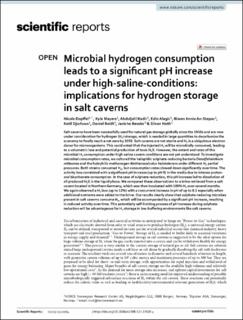| dc.contributor.author | Dopffel, Nicole | |
| dc.contributor.author | Mayers, Kyle | |
| dc.contributor.author | Kedir, Abduljelil | |
| dc.contributor.author | Alagic, Edin | |
| dc.contributor.author | An-Stepec, Biwen | |
| dc.contributor.author | Djurhuus, Ketil | |
| dc.contributor.author | Boldt, Dabiel | |
| dc.contributor.author | Beeder, Janiche | |
| dc.contributor.author | Hoth, Silvan | |
| dc.date.accessioned | 2023-08-17T10:39:11Z | |
| dc.date.available | 2023-08-17T10:39:11Z | |
| dc.date.created | 2023-07-18T10:57:01Z | |
| dc.date.issued | 2023 | |
| dc.identifier.citation | Scientific Reports. 2023, . | en_US |
| dc.identifier.issn | 2045-2322 | |
| dc.identifier.uri | https://hdl.handle.net/11250/3084554 | |
| dc.description.abstract | Salt caverns have been successfully used for natural gas storage globally since the 1940s and are now under consideration for hydrogen (H2) storage, which is needed in large quantities to decarbonize the economy to finally reach a net zero by 2050. Salt caverns are not sterile and H2 is a ubiquitous electron donor for microorganisms. This could entail that the injected H2 will be microbially consumed, leading to a volumetric loss and potential production of toxic H2S. However, the extent and rates of this microbial H2 consumption under high-saline cavern conditions are not yet understood. To investigate microbial consumption rates, we cultured the halophilic sulphate-reducing bacteria Desulfohalobium retbaense and the halophilic methanogen Methanocalculus halotolerans under different H2 partial pressures. Both strains consumed H2, but consumption rates slowed down significantly over time. The activity loss correlated with a significant pH increase (up to pH 9) in the media due to intense proton- and bicarbonate consumption. In the case of sulphate reduction, this pH increase led to dissolution of all produced H2S in the liquid phase. We compared these observations to a brine retrieved from a salt cavern located in Northern Germany, which was then incubated with 100% H2 over several months. We again observed a H2 loss (up to 12%) with a concurrent increase in pH of up to 8.5 especially when additional nutrients were added to the brine. Our results clearly show that sulphate-reducing microbes present in salt caverns consume H2, which will be accompanied by a significant pH increase, resulting in reduced activity over time. This potentially self-limiting process of pH increase during sulphate-reduction will be advantageous for H2 storage in low-buffering environments like salt caverns. | en_US |
| dc.language.iso | eng | en_US |
| dc.rights | Navngivelse 4.0 Internasjonal | * |
| dc.rights.uri | http://creativecommons.org/licenses/by/4.0/deed.no | * |
| dc.title | Microbial hydrogen consumption leads to a significant pH increase under high-saline-conditions: implications for hydrogen storage in salt caverns | en_US |
| dc.title.alternative | Microbial hydrogen consumption leads to a significant pH increase under high-saline-conditions: implications for hydrogen storage in salt caverns | en_US |
| dc.type | Peer reviewed | en_US |
| dc.type | Journal article | en_US |
| dc.rights.holder | © The Author(s) 2023 | en_US |
| dc.description.version | publishedVersion | en_US |
| cristin.ispublished | true | |
| cristin.fulltext | original | |
| cristin.qualitycode | 1 | |
| dc.identifier.doi | 10.1038/s41598-023-37630-y | |
| dc.identifier.cristin | 2162671 | |
| dc.source.journal | Scientific Reports | en_US |
| dc.source.pagenumber | 12 | en_US |

